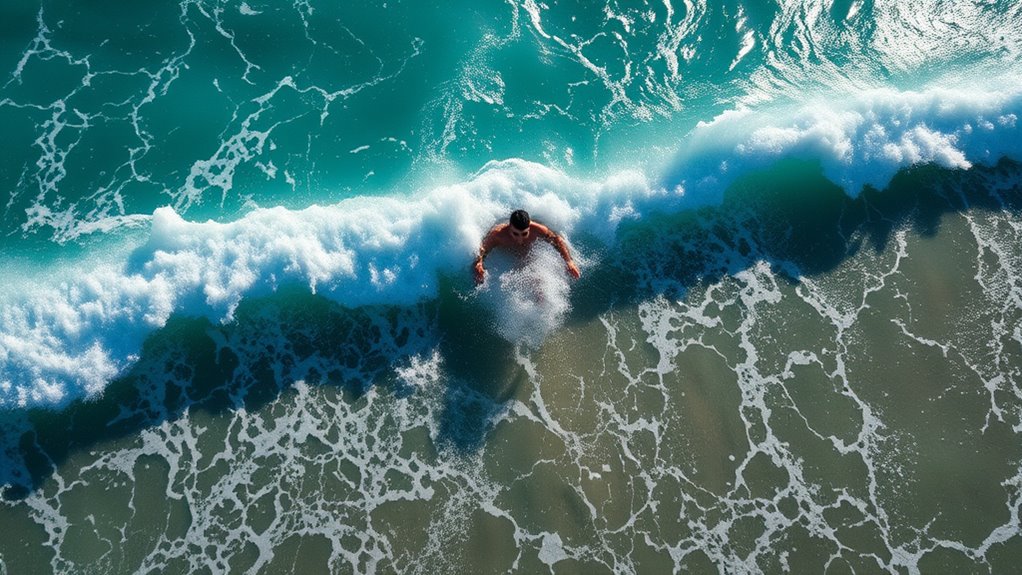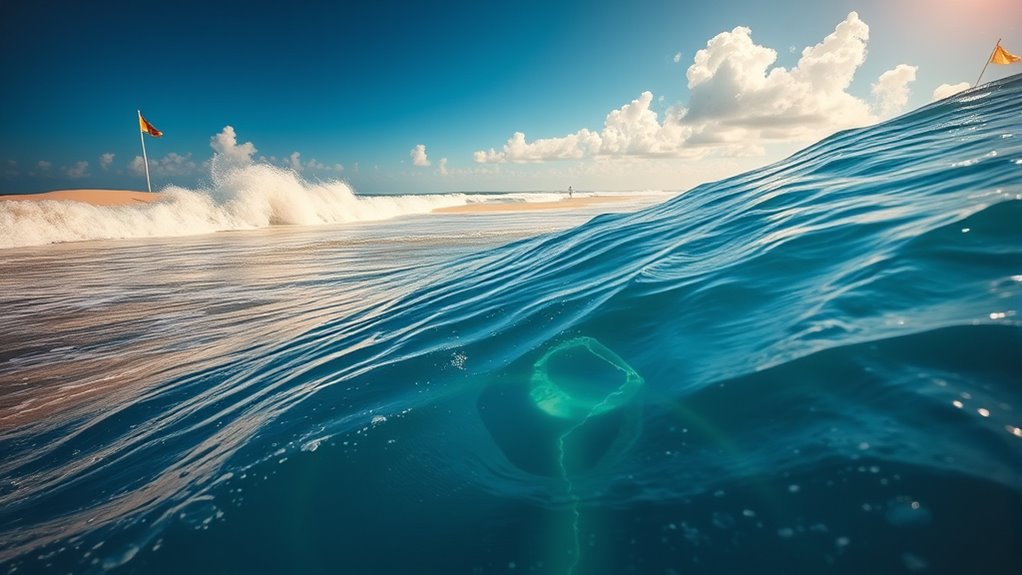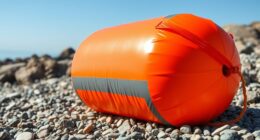Rip currents can secretly pull you away from the shore fast and unnoticed until it’s too late. They often hide near structures or between breaking waves, making them hard to spot. To outsmart them, stay calm, avoid fighting the current, and swim parallel to the shoreline until you’re free. Recognizing these dangers and knowing how to respond can save your life—keep going, and you’ll discover how to stay safe in and around the water.
Key Takeaways
- Rip currents can be nearly invisible, hiding beneath calm water areas, making detection difficult for swimmers unfamiliar with their signs.
- They can quickly pull swimmers away from shore, increasing the risk of exhaustion and making rescue more challenging.
- Many underestimate rip currents’ strength, leading to dangerous attempts to swim against them instead of escaping sideways.
- Structures like piers and jetties often create rip current channels, which can be hidden or hard to spot from the shoreline.
- Staying calm, swimming parallel to the coast, and signaling for help are essential strategies to outsmart and escape rip currents.

Rip currents are powerful, narrow channels of fast-moving water that can quickly pull swimmers away from the shore, often catching even experienced surfers off guard. If you’re heading to the beach, understanding how these currents work is essential for your swimming safety and overall beach awareness. Rip currents aren’t surfers’ playgrounds—they’re dangerous, unpredictable, and often invisible until it’s too late. Recognizing their presence and knowing how to respond can make all the difference between a safe swim and a life-threatening situation.
Rip currents are dangerous, fast-moving channels that can pull swimmers away unnoticed. Recognize and respond to stay safe.
First, learn to identify rip currents before you even get in the water. Look for areas where the water appears calmer than the surrounding surf, or where there are fewer breaking waves. Sometimes, you might notice a channel of choppier water or a gap in the breaking waves, which can signal a rip current. Be aware that they often form near piers, jetties, or other structures that alter normal water flow. The key to beach awareness is constantly observing your environment, so you can spot these subtle signs quickly.
Once you’re in the water, if you find yourself caught in a rip current, stay calm. Panicking will only sap your energy and make it harder to think clearly. Instead, conserve your strength and focus on swimming parallel to the shoreline rather than against the current. Rip currents tend to flow straight out, so breaking free by swimming sideways often gets you out of the danger zone faster. Remember, most rip currents aren’t powerful enough to pull you underwater; their strength lies in their ability to carry you away from the shore rapidly.
If you’re too exhausted to swim out of the rip current, don’t fight it. Instead, float or tread water and signal for help. Wave your arm and shout if you need assistance, but don’t try to swim directly back to the beach against the current. Instead, keep your composure and wait for rescue or for the current to weaken. When the current loses its strength, typically near the shoreline, swim at an angle toward the beach rather than directly into the current. Being aware of beach safety guidelines can help you respond more effectively in emergencies.
Practicing good swimming safety and staying aware of your surroundings at the beach are your best defenses against rip currents. Always swim at beaches with lifeguards on duty, and heed their warnings and flags. By understanding the hidden dangers of rip currents and how to respond, you can enjoy your time at the beach safely and confidently. Being prepared and alert helps you stay in control, ensuring your beach day remains fun and safe.
Frequently Asked Questions
Can Rip Currents Form in All Ocean Types and Conditions?
Rip currents can form in most ocean types and surf conditions, but they’re most common in open coastal waters with strong waves. You might see them in calm or rough seas, depending on how the tide and underwater features influence water flow. Always stay alert to changing surf conditions and ocean type, as these factors can increase the likelihood of rip current formation. Recognizing signs helps you stay safe while enjoying the water.
How Do Rip Currents Behave During Storms or High Surf?
Imagine you’re caught in a rip current during a storm, with towering wave heights and storm surge pounding the shore. During storms, rip currents intensify, become faster, and can extend further offshore. The increased wave height and storm surge push more water into the surf zone, strengthening these currents. You must stay calm, avoid fighting the current, and swim parallel to the shore until you’re free, then head back to land safely.
Are There Any Signs That Indicate a Rip Current Nearby?
You can spot warning signs of a rip current by paying attention to color changes in the water, like darker patches where water looks calmer. Look for areas with fewer breaking waves or gaps in the surf. If you notice debris or seaweed being pulled away from the shore, it’s another sign. These visual cues help you identify rip currents before venturing into the water, keeping you safe.
What Equipment Can Help Identify or Escape Rip Currents?
Imagine a lighthouse guiding you through stormy seas—buoy markers serve a similar purpose, helping you spot rip currents from afar. Carrying rescue tools like a whistle, a rope, or a flotation device can be lifesaving if you’re caught in one. These tools help you identify rip currents early and escape safely. Always stay alert, and rely on these essential equipment pieces to stay safe in the water.
How Effective Are Lifeguard Interventions in Rip Current Rescues?
Lifeguard interventions are highly effective in rip current rescues, thanks to rigorous lifeguard training that prepares them for quick, decisive actions. Their expertise markedly boosts rescue success rates, helping swimmers escape dangerous currents safely. You can trust that trained lifeguards are well-equipped to handle rip current emergencies, reducing risks and saving lives. Their presence and prompt response are vital in ensuring swimmer safety during these hazards.
Conclusion
Understanding rip currents can save your life. For example, imagine you’re caught struggling in a powerful rip, but remembering to stay calm and swim parallel to the shore helps you escape. Always heed warning signs, stay aware of changing conditions, and don’t panic if you get caught. Outsmartting rip currents isn’t about fighting them but understanding their patterns. With knowledge and calm action, you can enjoy the beach safely and avoid becoming another hidden danger’s victim.










